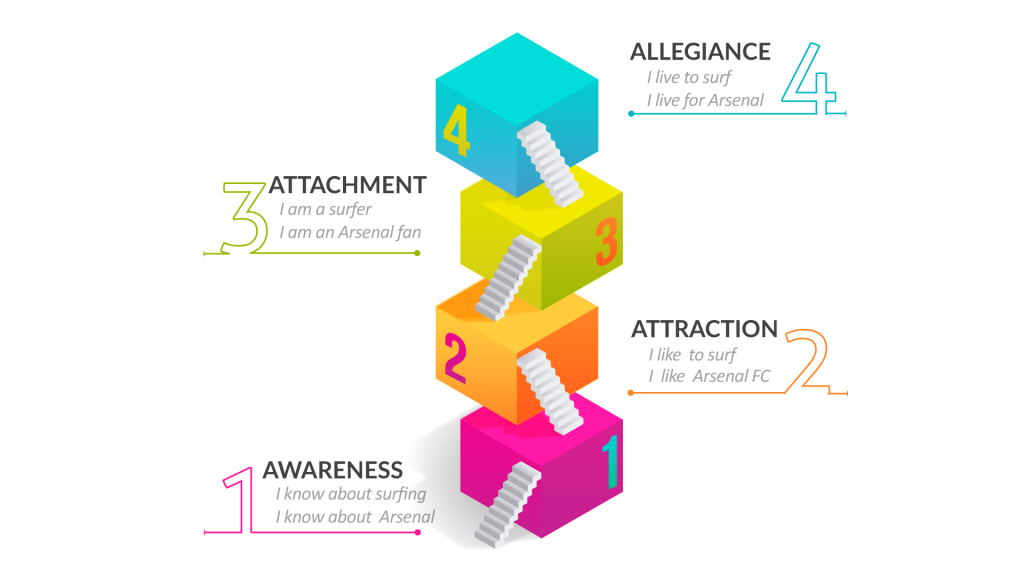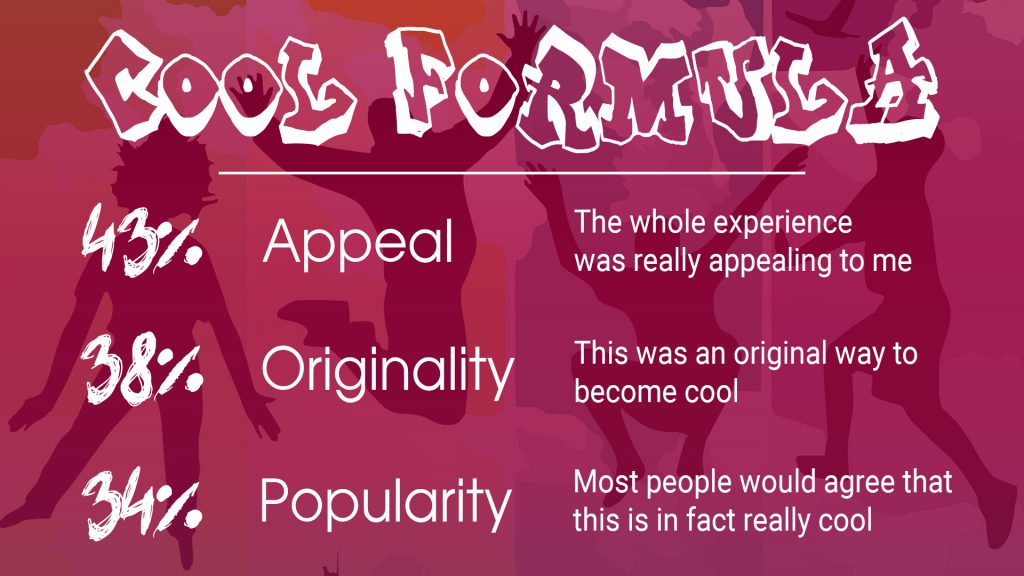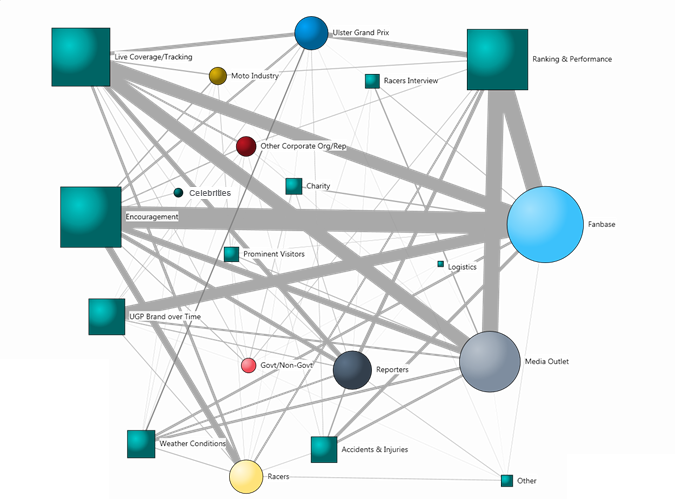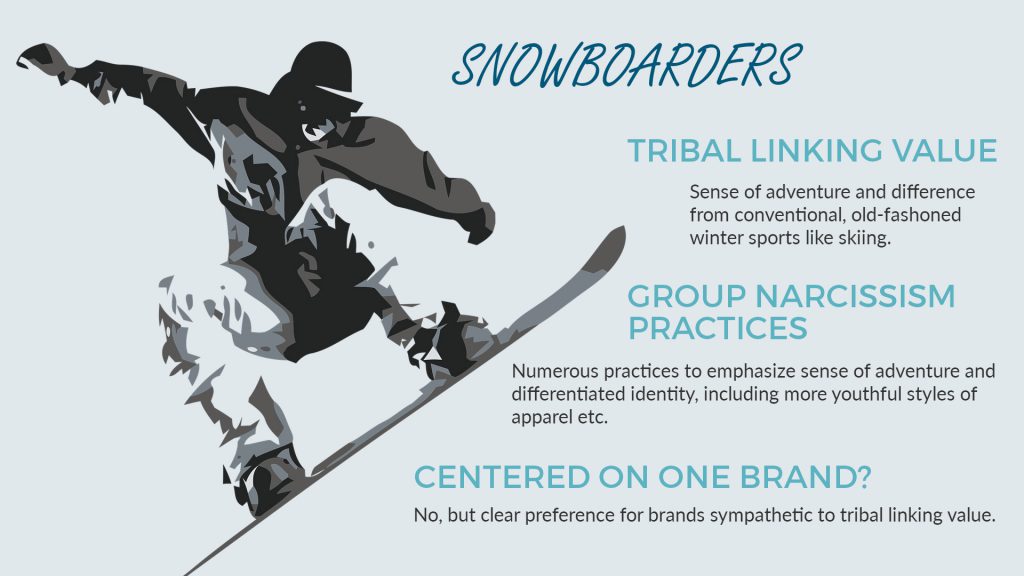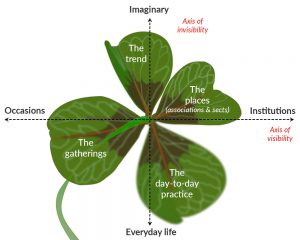Most discussions about social media analytics in sport, and sport marketing in general, focus on using social data insights to increase fan engagement, citing isolated examples of successful social media campaigns in sports.
Consumer behaviour in sport and events, however, is unique and quite different from other industries such as FMCG, warranting a deeper analysis in itself.
The purpose of this blog post is to look at social media marketing and analytics through the prism of sport consumer behaviour, and to speculate why some social media platforms may be more appropriate for engaging sport consumers along the different stages of the consumer journey than others.
The Psychological Continuum Model (PCM)
PCM was developed in 2001 by Daniel Funk and Jeff James, and it is one of the most extensive frameworks for explaining sport and event consumer behaviour. It suggests that engaging in continuous sport consumption activities, such as watching or playing sports, progresses along four general hierarchical stages: awareness, attraction, attachment, and allegiance.
The job of the sport marketer thus boils down to moving consumers up the PCM elevator aiming to reach at least the Attachment stage.
The PCM staging tool is based on the concept of involvement, which is defined by researchers as a psychological construct that represents a person’s level of interest, desire and motivation to engage in a sport and related consumption activities.
Furthermore, in order to better understand the concept of involvement, marketers need to look into its underlying facets: pleasure, centrality, and sign.
- Pleasure – the enjoyment derived from the activity.
- Centrality – how central the activity is to the individual’s lifestyle
- Sign – the self-expression, or symbolic value of the activity
Apart from measuring each of the three involvement facets to create an involvement profile of sport consumers, sports marketers can use them to calibrate social media marketing strategies designed to move consumers up the PCM elevator.
Awareness
When we talk about awareness in sport, the most important inputs that marketers need to consider are the various socialising agents through which sports objects are introduced to a person’s life: parents, peers, media, schools, etc., and most important for sports- sport subcultures.
Social media is definitely one of the socialising agents that is increasing in importance, especially for younger consumers- generations Y and Z. Its role is getting even more prominent when we consider the interplay between online communities and sport subcultures, and the individuation of some sport subcultures through social media. We can define sport subculture as a group of people that self-selects based on shared beliefs, rituals, and commitment to a particular sports consumption activity.
From a social media point of view, viral marketing is a highly recommended strategy for socialising consumers into sport and through sport due to the minimal cognitive effort and simplistic behaviour required in the awareness stage.
An excellent example of a viral social media campaign designed to socialise consumers through sport is Nike’s Da Da Ding campaign in India.
Sport is a key site for masculine identities and its representational significance is apparent in its common cultural deployment as a metaphorical and intertextual referent. Thus, the media constitutes a predominant domain for the construction and reproduction of sport as highly masculinized sex-typed kind of activity.
To challenge the prevailing discourse on sport and gendered identities in India, Nike commissioned a crew of female household celebrities that best represent sport in India with a view to presenting athleticism as aspirational, and sport as sexy.
Measuring the awareness generated through viral or buzz marketing is usually quantitative in nature and can include the quantification of simple actions through web analytics (e.g. number of views or reads) or counting the number of mentions of a brand and/or its products, or relevant topics, through social listening.
For example, listening to the social conversations on Facebook around Nike in India during the period when the Da Da Ding campaign was launched, yielded the following results:
Looking at the topics driving engagement, it can be seen that the virality of the campaign was largely caused by some of the female athletes featuring in the video, such as the Indian film actress and former national badminton player Deepika Padukone, national hockey player Rani Rampal, and national football player Jyoti Ann Burret.
Why is Facebook an appropriate socialising agent for sport, especially among younger consumers?
To answer this question, we need to look deeper into the motivations young people have for using Facebook. Although Facebook’s usage among teens has been declining over the last few years, it is still by far the largest social platform and mobile app used by teens globally.
Furthermore, teens’ use of Facebook is a form of peer-based learning, a space of identity exploration and experimentation, which can have an important role in their socialisation into sport.
In this regard, research shows that on Facebook, group and consumer identity is emphasised more than a personally narrated identity, i.e. users are more about “show” rather than “tell”.
Attraction
An important differentiator between the Awareness and Attraction stages in sport consumer behaviour is the existence of volition. While Awareness does not involve volition, Attraction occurs only when an individual consciously and willingly selects to engage into a favourite sport activity.
The Attraction stage provides a number of opportunities and challenges for sport marketers. Marketing activities that focus on promoting desirable inputs (i.e. functional attributes and intangible benefits) to sport spectators and participants can influence the progression from Awareness to Attraction.
In terms of the involvement profile of sport consumers in the Attraction stage, it is high in pleasure and low in sign and centrality.
A marketing strategy designed to move consumers from awareness to attraction should aim to trigger an emotional response and increase consumers’ pleasure in engaging in sports. Naturally, the tools to achieve that will depend on the specific market segments being targeted.
In a recent webinar titled “Sports Marketing 3.0: Transmedia and The Power of Social Data,” one of the questions I got was:
What is key to helping attract younger fans for sports?
And here is the answer in two words: Being cool!
As vague as it may sound, there has been considerable research into Generation Y’s definition of ‘cool’ and thanks to Joeri Van den Bergh and Mattias Behrer, and their award winning book “How Cool Brands Stay Hot: Branding to Generations Y and Z,” we now have the cool formula which can help us investigate which brands are capable of touching the hearts of Generations Y and Z.
Researching 375 products and brands through the eyes of more than 1,500 teenagers and young adults (13-29), Van den Berg and Behrer discovered that the cool formula is as follows:
Unsurprisingly, the researchers found that not all product categories are equally cool, and the cool formula for sports brands was determined to be:
The implications of the cool formula for sport marketers is that popularity has significantly less contribution to a brand’s cool status, which would go on to say that using influencers to promote sports brands with youngsters might not be as effective as working on originality, for example in product innovation or communication, or working on appeal to design experiences that engage them emotionally.
One strategy to inject creativity into sports brands’ social media presence and attract younger fans is to host a ‘Snapchat takeover’, which involves inviting somebody, e.g. a celebrity athlete, to take over your Snapchat account and document a sport event.
A case in point is the Snapchat takeover hosted by Wimbledon, when they had Serena Williams take over their account for a day during the event.
The problem with these new forms of sharing is that they create a form of ‘dark social’ because traditional analytics don’t work here anymore. Measuring engagement on dark social channels such as Snapchat, WhatsApp, etc., is very difficult requiring marketers to constantly experiment to understand how they work.
Attachment
Attachment represents the emotional, functional, and symbolic meaning an individual places on a sport object, which is strong enough to motivate behaviour. It is also closely tied to the formation of a sport self-concept through internalization, i.e. when a sport object becomes an integral part of one’s self-image.
Sport marketing strategies within the attachment stage involve personalization, and in fact, the majority of customer loyalty programs currently being employed in sport marketing are designed to move an individual from attraction to the attachment stage.
The use of Twitter analytics to study how best to engage sport fans in the attachment stage is advisable not only because of Twitter’s open nature and sizable bank of public data, but also because it is an accurate representation of what fans care about and how you can reach them.
Twitter analytics can inform sport marketers’ personalization efforts to increase the personal meaning of the sport product or service. This follows from Twitter’s affordance as a communicative space where the idea of personal publics, i.e. the selection of information by criteria of personal relevance for a known, networked audience in a conversational mode, comes to the fore.
To aid sport brands’ personalization efforts, basic Twitter analytics tools allow them to segment their Twitter followers by demography or geography, or to use filters to find interesting or influential followers, etc.
However, simple geographic and demographic segmentation is not of much help in fostering sports fan identification with a brand.
Twitter, like other social media, flattens diverse social contexts and audiences into one, a phenomenon known as ‘context collapse,’ pointing to the need to perform advanced analytics to gain meaningful insights into the conversation topics driving engagement among fans.
For example, using content analysis and Commetric’s patented Influencer Network Analysis methodology on a large sample of tweets about the World’s Fastest Road Race – the Ulster Grand Prix (UGP), allowed us to visualise the most discussed topics and their connectors to the most prominent audiences in the Ulster Grand Prix conversation on Twitter.
The squares on the cluster map above represent the discussion topics that make up the conversation, isolated through content analysis, and the circles represent the various audiences that take part in the discussion.
The size of the squares and the circles illustrates the centrality of the topic or the audience in the discussion.
Centrality is important as it does not rely on a simple number of Twitter users or mentions, which can be misleading, but instead applies a mathematical method used in network analysis, to measure the quantity and quality of connections– similar to Google’s page ranking methodology.
Finally, the thickness of the connectors between the topics and the audiences represents the level of engagement of the respective audience with the discussion topics.
One of the important observations from this analysis is the potential of the topic on the ‘UGP Brand over Time’ to drive engagement and its under-exploitation on the part of the UGP (which is represented as a separate audience on the map). This type of influencer mapping is invaluable in identifying key influencers and emerging topics in social media as well as the endorsers, swing voters and critics in a conversation.
Allegiance
Sport marketing activities designed to move fans to the Allegiance stage of the PCM model are focused on increasing their loyalty and devotion to a sport object.
Marketing research usually deals with two types of consumer loyalty: attitudinal and behavioural.
In this regard, the difference between the Attachment and Allegiance stages in sport consumer behaviour is the attitudinal strength, i.e. allegiance strengthens the emotional, functional and symbolic meaning of the sport object.
High consumer loyalty – both attitudinal and behavioural – is typical of consumer tribes. Sport marketers can thus view sport fans as ‘tribes’ and adopt a tribal marketing and branding approach to creating allegiance.
Sport fandom just like consumer tribes is founded on a shared passion for activities or objects people willingly choose to become excited about. Therefore, it is important for sport marketers to study what the marketing guru of contemporary consumer tribes Bernard Cova calls ‘linking value’, to indicate that tribes gather together around what they collectively imagine or construct as a set of shared values, practices, and emotions, which sometimes may be represented by tangible objects and brands, and sometimes not.
Another important aspect of consumer tribes, and hence of sport fandom, is group narcissism, which has to do with demonstrating and affirming fans’shared identity through taking part, often in a highly visual way, in tribal activities.
Thus, a consumer tribe around snowboarding, for example, can be described as follows:
Source: Richardson(2013)
The author of one of the most comprehensive books on tribal marketing “Tribal Marketing, Tribal Branding: An Expert Guide to The Brand Co-CreationProcess,” Brendon Richardson, makes a very important point that tribal marketing is not the same as social media marketing, as currently practiced by many organisations.
It is frustrating to see how many brands use social media such as Facebook and Twitter to attempt to target consumers with a corporate rather than co-created message, assuming that a tribe is the same as a market segment, when it is not.
In the allegiance stage of PCM model, the most important application of social media is to serve as a platform for meaning co-creation, which sport marketers should encourage by:
- Engaging the community in the design of products and services that support the linking value
- Launching products and services that support the linking value, accompanied by marketing communications that favour tribal-friendly media.
For example, the Ulster Gran Prix recently launched an app, which among other things, allows fans to stream their thoughts and photos through an interactive ‘Tagboard’, presumably supporting motor bikers’ over the top exhibitionism.
In the Allegiance stage of sport consumer behaviour, sport marketers can derive the most value from social media if they use it for digital or virtual ethnographic research, also called netnogpraphy.
Extending ethnographic research into social media can generate deeper and richer insights than conventional offline research alone, which is facilitated by the fact that contemporary tribes, especially in sports, are very active online as well as offline.
But how to study sport tribal activities and identity on social media?
In their study of consumer tribes, Bernard and Veronique Cova come up with the idea of the Tribal Clover, which can help sport marketers distinguish between visible and invisible aspects of tribal identity.
Visible or tangible aspects of the tribe are positioned on the horizontal axis of the Tribal Clover: these are institutions, e.g. fan clubs, and occasions such as sporting fixtures, competitions, etc. It is important to note that gatherings can take place also online, which facilitates netnographic research.
Researching the intangible aspects of tribes as presented on the vertical axis of the clover poses a bigger challenge for sport marketers, because trends are usually not directly observable. The solution Cova and Cova propose is to study the daily practices and shared experiences of individual members of the tribe in order to gain insight into the fantasies that might lie behind the visible behaviours.
In this regard, using Twitter for a netnographic study of sport tribes is clearly essential if it is something that fans make frequent use of. It provides sport marketers with an invaluable opportunity to inconspicuously observe and make sense of fans’ daily practices.
Using advanced Twitter analytics and Influencer Network Analysis as discussed in the Attachment section above provides sport marketers with key influencers and topics, whose more detailed discussions can be pursued elsewhere.


